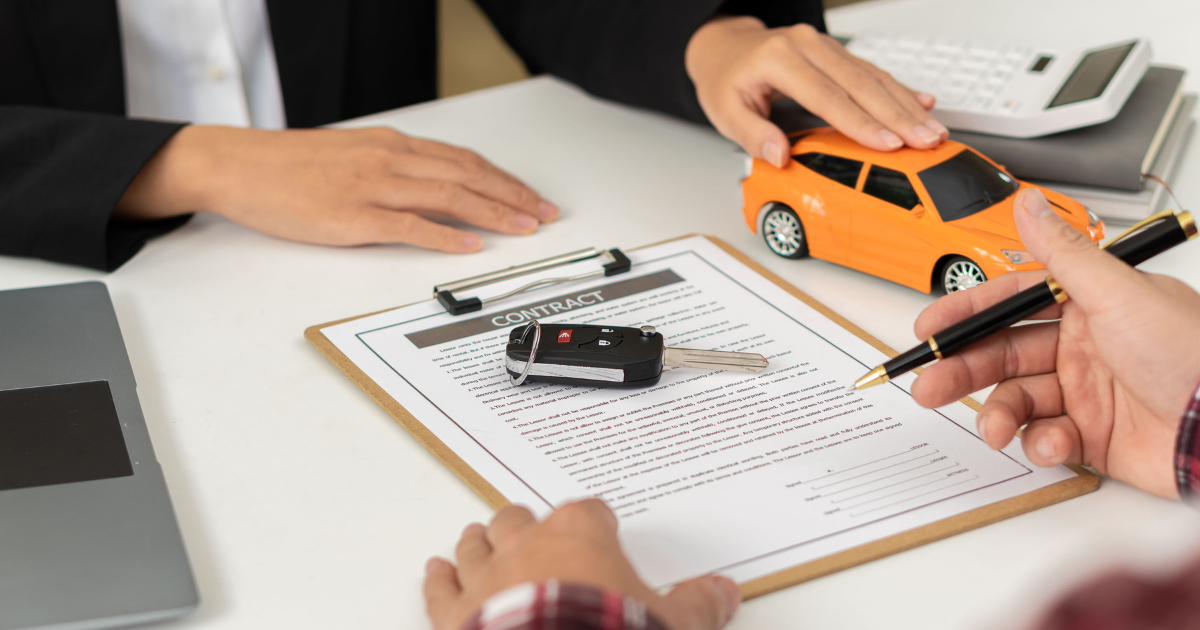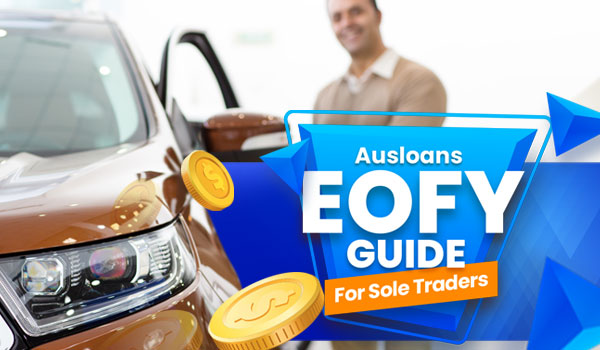It’s an oft-quoted adage that buying a car is the second most significant purchase you can make.
With the commitment of large amounts of money at stake, it can be a daunting experience to know what to do and make sure you get yourself the best deal possible, especially if you go with the option of financing.
But, it needn’t be so intimidating as long as you are well-informed. Here’s what you need to know before purchasing a car through financing.
EOFY for Sole Traders Checklist


Car Finance Basics: What to Know
Before you dive straight into the car financing process, you should make sure you have a firm grasp of the basics of car finance - the core principles and some of the key terminology. A general understanding of the concept will breed confidence, helping you head into the dealership to negotiate your deal from a better position.

What is an Interest Rate?
The interest rate is the amount a lender charges a borrower. It is a percentage of the initial amount loaned - also known as the principal. In this way, you can see it as a fee added to the cost of the car by the lender; it is the price of the risk they are taking. The interest rate affects how much you pay in your monthly payments.
Here is the formula for calculating your added monthly interest:
Monthly interest = (interest rate ⁄ 12) x loan balance
To put all this into a basic example, let’s say you get an interest rate of 6% on a loan balance of $20,000:
Monthly interest = (0.06 / 12) x 20,000 = $100
The $100 in this example is added to your monthly payments paying back the loan over an agreed period.

What is Repayment?
Since car financing means getting a loan to buy a car, repayment refers to paying back that loan over time with the added fees and interest. It is important o understand that your total repayment will add up to more than the value of the vehicle. Although you end up paying more, the benefit is that you don't have to outlay all the money for your vehicle upfront.

How Long Does Repayment Take?
The length of time you agree on depends on your personal circumstances and what you decide on in the dealership. The average in Australia is five years for a car loan, meaning you will pay back your loan plus interest for five years. At the end of the five years, the car is fully yours. Over time, though, your vehicle will decrease in value, so, depending on your circumstances, it would be better to pay off your loan sooner if possible.

Unsecured vs Secured Finance
What is the difference between unsecured and secured finance? Secured finance is a loan where some assets are put up as collateral, meaning that, if you default on your payments, something can be taken away. Unsecured finance is where there are no assets as collateral.
Car loans are typically secured finance because the car is the asset that can be taken away.
This means that the lender has less risk since they can retain the asset - the car in this case. This means secured finance options have cheaper interest rates than unsecured finance options.

What is the Difference Between Business and Personal Use?
Whether you use your car for business or personal use affects your interest rate. Personal use means you use your car for your everyday needs - commuting to work, heading to the shops, and other such trips. Business use means that the vehicle is solely used for purposes associated with your business, like making deliveries or travelling to meet with clients. Some loan types are only available for business-use vehicles.
What Will I Need to Show When Applying for Car Finance?

From the lender’s perspective, they need a range of information to determine how much of a risk you are when considering you for car finance. Their calculations will affect the interest rate that they offer you.
To make this calculation, they may need to see:
- Your basic contact information
- Bank statements
- Credit card statements
- Drivers license
- Copies of bills
This helps them build a picture of you and your credit history to make you an offer for car financing.
It is essential that you get the best rate possible since small changes in interest rates can significantly impact the amount you pay overall. For example, a car loan of $30,000 at 6% paid back over 72 months would cost $5,797 in interest. The same loan with a 5% interest rate would mean paying $4,787 in interest - saving more than $1,000 versus the same loan at 6%.
That’s why it pays to understand the whole process and shop around for deals before committing to a purchasing decision.
Let’s look at how you can negotiate the best deal when financing a car, particularly when buying at the end of the financial year.

5 Tips When Financing a Car at the EOFY
Now that you know the basic principles of car financing, let’s examine 5 actionable tips to take into the dealerships.
1. Leverage EOFY Sales
For many reasons, buying a car at the end of the financial year can be an excellent option for those looking to get a good deal. At this time, many car manufacturers and dealers look to drop prices as they need to meet sales targets at the EOFY. They face pressure to shift stock from the shop floor, getting rid of older models to make space for new stock coming in.
So, as a consumer looking to buy a car at the end of the financial year in June, you can leverage the situation in your favour. Many dealerships will already have discounted prices, but there will probably be even more wiggle room for you to negotiate to get an even lower price from the dealership.
2. Don’t Go With Bank Financing
Banks will often present you with financing options that may offer seemingly attractive low-interest rates that, at first glance, may seem tempting, especially for the security and reputation associated with traditional banks.
However, these offers of low rates are often supplemented with high upfront or ongoing fees, making the whole package considerably more expensive than with other lenders. It is best to explore options from alternative providers for your auto loan instead of simply taking the bank option.
3. Take the Time to Shop Around
As with any significant purchase, it’s vital to shop around to get the best deal for your car. You need to take the time to compare a few different dealerships, getting a feel for the price on the market for your chosen car and who may be more willing to negotiate on that price. At the end of the financial year, many dealerships offer enticing discounts and deals, but it can be challenging to make sense of all that’s on offer - make sure you take the time to explore these options.
There are also offers such as ‘We’ll beat any price”. Take advantage of these, and play dealers off each other in an attempt to get the price down. To get the best deal possible, you should also see the different optional extras that could get thrown in to sweeten the deal.
4. Know When to Walk Away!
It’s another old adage to speak with your feet as a buyer. Walking out the door means you are potentially going elsewhere to make your purchase - and dealers hate to see that! Knowing when to walk away can be a great negotiating tactic to seal the best end of the financial year car financing deal.
It’s okay to go away and shop around. This may encourage the dealer to offer you a better deal. But, even if they don’t bite, you can always come back later as it’s unlikely that the offer will be off the table.
Remember, the dealer needs to hit their sales targets at the end of the financial year, and, ultimately, they want to get the deal done.
5. It’s Not Just 4 Wheels - Check All the Extras
Considering all the extras is a double-edged sword. On the one hand, adding in some optional extras can be a great way to sweeten a deal. On the other hand, a dealer can add a load of optional extras to bump up the price when you don’t really need or want them.
Would extra fancy alloys interest you? What about a roadside assistance package? An extended warranty may be worthwhile, but then perhaps you don’t plan on owning the car that long anyway. Having said that, it’s a good idea to get a warranty that covers the period of your loan
It’s good to know what you want before you head into the dealership - whether you want the leather seat upgrade, for instance. Knowing what you want gives you clarity when deciding on the finer details. You won’t be swayed by dealers offering you seemingly tempting deals for optional extras that you’re simply not interested in.
Ultimately, you need to gauge what’s important to you as the buyer based on your personal preferences and circumstances.
Additional Considerations for EOFY
While the above tips are crucial, there are additional aspects to consider at the end of the financial year, especially if you are a sole trader or running a small business. Here are some extra tips:
1. Update Your Paperwork

At EOFY, there’s a lot of paperwork for you to navigate. You need to locate all of it and get it in order to have a clear picture of your financials, meaning you have the precise figures for your balance sheet and profit and loss statement.
2. Establish What Tax Deductions You Can Claim

Here in Australia, you can claim deductions for all sorts of business expenses for things that you pay for to keep your business running smoothly. However, you need to keep receipts for these purchases to establish a paper trail throughout the financial year.
3. Assess Your Business Equipment

You may be able to claim deductions on any business equipment that you use for your business's daily operations - you can claim depreciation on the loss of value and general wear and tear.
4. Keep Up to Date With Changes

Don’t simply assume that because something was in place last year, the same applies this year. The laws surrounding tax deductions can change, while there may be alterations in the concessions available to your business. A competent tax professional can tell you about the latest changes to make sure you follow the law and don’t over or underpay.
5. Be Wary of Scams

Some individuals particularly seek out sole traders vulnerable to misinformation. Relatively common tax scams include those that claim you are eligible for a tax refund but explain that you must pay a fee or administration cost to receive it. On the other end, some scammers send notifications that you have underpaid and must pay the outstanding balance immediately, asking you to supply your credit card information.
If you suspect any messages are scams, you should contact a local tax professional or the ATO office.
6. Carry Out a Stocktake

If your business buys and sells any stock, we recommend performing an EOFY stocktake. This will allow you to assess where you are with your inventory - evaluating the value of your stock and writing off any lost or damaged goods.
7. Carry Out Financial Reporting

Number 1 on this list relates to updating your paperwork, and part of that process is producing a balance statement and a profit and loss document. These should form the basis of your financial reporting.
8. Secure Your Files

It’s good practice to establish good habits around EOFY. It is self-evident that the process of declaring your taxes is heavily reliant upon thorough record-keeping. Around EOFY, you should digitise all of your records and receipts and file them appropriately on a hard drive. If you have all your files stored on a laptop or computer, back them up regularly to ensure they are safe and secure.
9. Calendarise Important Due Dates

You must lodge your tax returns each year. This is a fact of life for any sole trader. However, the date by which you are obligated to submit your details depends on your business structure.
For sole traders specifically, you can lodge your tax returns at any point from 1 July to 31 October each financial year. While this may seem like a broad period, we advise setting strict deadlines within this time for when you need to have certain things ‘done’. That’s because there is a long, complex checklist for all the things you need to do, so you don’t want this to creep up on you.
Careful planning and adherence to a schedule will help the whole process go much smoother. You should also establish deadlines with your tax agent.
Get Help with AusLoans
Whether you are looking to secure finance for your first car or upgrade to the latest luxury vehicle, at Ausloans, we've got you covered with plenty of free help and advice.
Check out our car finance calculator to help estimate your repayment schedule.
Chat with one of our friendly car lending specialists today to find out your personalised rate for car financing. Help prepare for the end of the financial year buying season and make the most of the available deals.

-1.png?width=250&height=84&name=MicrosoftTeams-image%20(29)-1.png)






.png)























No Comments Yet
Let us know what you think